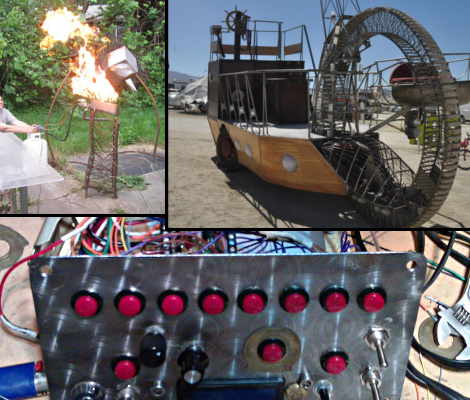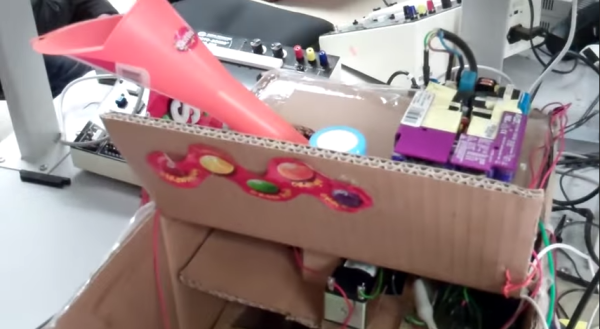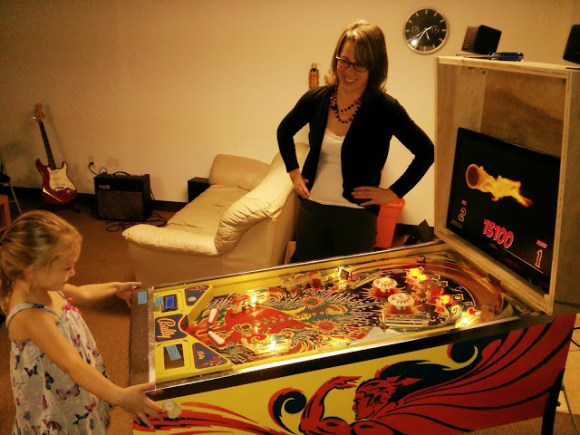As far as giving mechanical instruments electronic control goes, drums are probably the best candidate for conversion; learning to play them is challenging and loud for a human, but they’re a straightforward matter for a microcontroller. [Jeremy Cook]’s latest project takes this approach by using an Arduino Opta to play a tongue drum.
[Jeremy]’s design far the drum controller was inspired by the ring-shaped arrangement of the Cray 2 supercomputer. A laser-cut MDF frame forms a C-shape around the tongue drum, and holds eight camera mount friction arms. Each friction arm holds a solenoid above a different point on the drum head, making it easy to position them. A few supports were 3D-printed, and some sections of PVC tubing form pivots to close the ring frame. [Jeremy] found that the the bare metal tips of the solenoids made a harsh sound against the drum, so he covered the tips of six solenoids with plastic caps, while the other two uncoated tips provide an auditory contrast.
The Arduino Opta is an open-source programmable logic controller normally intended for industrial automation. Here, its silent solid-state relays drive the solenoids, as [Jeremy]’s done before in an earlier experiment. The Opta is programmed to accept MIDI input, which [Jeremy] provided from two of the MIDI controllers which we’ve seen him build previously. He was able to get it working in time for the 2024 Orlando Maker Faire, which was the major time constraint.
Of course, for a project like this you need a MIDI controller, and we’ve previously seen [Jeremy] convert a kalimba into such a controller. We’ve seen this kind of drum machine at least once before, but it’s more common to see a purely electronic implementation.
solenoids6 Articles
Taste The Rainbow One Color At A Time
It’s the end of another fall semester of Bruce Land’s ECE4760 class at Cornell, and that means a fresh crop of microcontroller-based student projects. For their project, [Alice, Jesse, and Mikhail] built a Skittle-sorting miniature factory that bags and seals same-colored candies into little pouches of flavor.
Their design is split into three stages, which are visually delineated within the all-cardboard housing. Skittles are loaded into a funnel at the top that leads to the color detection module. The color is determined here with an RGB LED and OPT101 photodiode driven by an ATMega1284. Because the reflected RGB values of red and orange Skittles are so similar, the detector uses white light to make the final determination.
Once the matchmaking is over, a servo in the second stage rotates to the angle that corresponds with the color outcome. The Skittle then slides down a cardboard chute, passes through a hole in a cardboard disk, and drops into a hanging bag. Once the bags have reached the predetermined capacity, another servo moves the carousel of bags to a nichrome wire sealing rig. Lead factory worker [Jesse] must intervene at this point to pull the bags off the line. You can see the full walk-through and demonstration of this Skittle flavor separator after the break.
Building An Entire Pinball Machine From Just The Playfield
It all started when [Iancole] bought a Fireball Home edition playfield on some famous auction website for $135. Originally, he had the intent of lighting the lamps with an Arduino, framing it, and hanging it on the wall of his office — which often happens with old pinball parts. But then his boys asked if he “could make it play”.
[Iancole] managed to find the pinball schematics online and started designing the electronics required by the many LEDs, solenoids and switches. As the LEDs and switches are on the same matrix, he chose a simple Arduino to cycle through them, giving the player the impression that the lights are constantly on. [Iancole] originally planned on using his raspberry Pi to control the solenoids, but he later switched to another Arduino because of the precise timing required.
Therefore, his Pi was used as the heart of the machine. It is interfaced to the two Arduinos to read states and send commands while running the game program, displaying HD graphics on a 24″ screen, playing music and game event sounds. All the electronics are proudly displayed on the backbox, and many developments are planned for it. Also, the machine will be on display at the Orlando Mini Maker Faire on October 5th!
Burning Man: Pirate Ship Sports Arduino Powered Flame Sails

The 2011 Burning Man festival starts in just a few short days, and with that we have an excellent mutant vehicle accessory that no insane desert dweller should be without. An Arduino powered fire cannon sequencer! [Paul] was asked by Lostmachine’s [Andy] to spice up the flame effects on their Priate Ship mutant vehicle and provide a cool looking fire show that represented the ship’s sails.
[Paul] tossed together a hand full of arcade buttons, switches, and an LCD display to control eight 12V Solenoid valves tasked with switching on various regulated propane sources that throw some brutal looking flame effects. The controller combines a Teensy 2.0 with a custom board that contains eight P-channel MOSFET circuits. Flyback from the coils is handled through zener diodes, and the IRFR5305s are sized quite above and beyond what is needed for the 12v solenoids. With the heat, dust, and chaos of the desert one can’t be too careful. [Paul] even tosses in RC snubber circuits just to prevent things from getting too out of hand. Of the twelve arcade buttons eight are used for manual over rides, and the remaining four arcade buttons, knobs, switches, and the LCD display are all connected to the Teensy to handle the sequencing. [Paul], sadly, will not be able to make it out to Burning Man to troubleshoot the sequencer, which is a cause for some concern throughout the build.
It just so happens that I leave for Burning Man this Friday, and have an 18″ by 18″ Hackaday QR Code that will mark my area, see if you can find me out there! Also check out a video of the sequencer controlling what is easily a 6 foot flame bar after the jump!
Continue reading “Burning Man: Pirate Ship Sports Arduino Powered Flame Sails”
Self Playing Bayan Built Nearly 22 Years Ago

The year is 1988, where a Russian engineer [Vladimir Demin] has combined a Bayan, or button accordion, with several (we lost count at about 96) solenoids. If that alone doesn’t blow your mind the computer, also hand built by [Vladimir], controls the whole process leaving the operator to only work the bellows. Putting truth to the fact in Soviet Russia, accordion plays you. We wish we could find some more information about the instrument, but curse our inability to read Russian. Alas check after the break for a shorter version of the video in the link above.
Related: Electronic accordion doesn’t compare.
Continue reading “Self Playing Bayan Built Nearly 22 Years Ago”
Arduino Solenoid Concert
[youtube=http://www.youtube.com/watch?v=g_hiz-Kx0kM]
[jay] reminded us of this old video of solenoids banging rhythms on furniture and household objects. There’s no schematic, but in the video it looks like an Arduino drives a bunch of solenoids through relays. The PC interface is run on Pure Data, an open source programming environment for audio, video, and graphic processing. Thanks [Jay].














